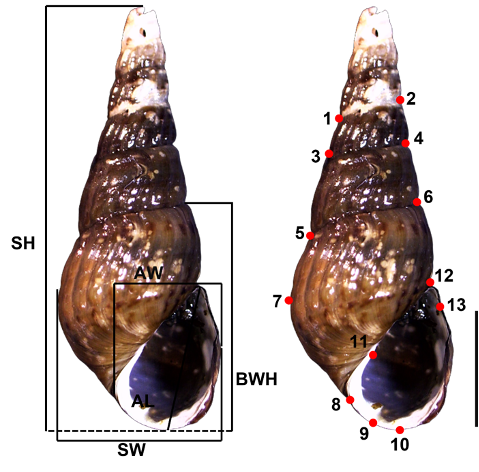VOLUME 16 NUMBER 1 (January to June 2023)

SciEnggJ. 2023 16 (1) 235-243
available online: June 24, 2023
*Corresponding author
Email Address: gacatalan1@up.edu.ph
Date received: June 16, 2022
Date revised: May 18, 2023
Date accepted: June 1, 2023
DOI: https://doi.org/10.54645/2023161ZHJ-49
ARTICLE
Shell morphometric variation of the freshwater snail, Melanoides tuberculata (Müller, 1774) across the seven lakes of San Pablo City, Laguna, Philippines
University of the Philippines Los Baños, College, Laguna, 4031
The seven maar lakes of San Pablo City in Laguna Province constantly face natural and anthropogenic disturbances that affect the water quality and habitat condition of various aquatic species, including freshwater gastropods. Freshwater gastropods exposed to multiple biotic and abiotic stressors are known to alter their shells as a form of ecomorphological adaptation. However, there are no studies yet regarding shell variations across these lakes as subjected to perturbations in water quality. The shell morphometrics of the common native freshwater snail, Melanoides tuberculata, distributed across the seven lakes was examined to address this research gap. Various water parameters were measured prior to collection of snails along the littoral zones. One hundred ninety-seven M. tuberculata shells were subjected to linear and geometric morphometrics. The biggest shells were sampled in Lake Sampaloc while the smallest was in Lake Bunot. Centroid size also contributed significantly to the shell shape variation. Generalized linear mixed modeling results suggest water temperature had the most significant effect on shell shape change. Shells exposed to colder waters exhibited wider and shorter whorls with constricted apertures, whereas those collected in warmer waters have slender and slightly taller whorls with expanded apertures. The present study demonstrated the possible plasticity of M. tuberculata shells which could serve as important information in understanding the habitat conditions of the maar lakes of San Pablo City.
© 2025 SciEnggJ
Philippine-American Academy of Science and Engineering